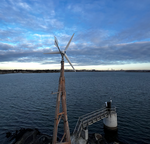News Release from U.S. Department of Energy (DOE)
Wind Industry Profile of
Biden-Harris Administration Announces $250 Million To Finance Energy Efficiency Upgrades For American Families And Businesses
The Biden-Harris Administration, through the U.S. Department of Energy (DOE), today announced it is accepting applications from all 50 states, five U.S. territories, and the District of Columbia for $250?million in formula funding through the Energy Efficiency Revolving Loan Fund Capitalization Grant Program. Established by President Biden’s Bipartisan Infrastructure Law, grants provided through this program will enable states and territories to establish revolving loan funds to invest in energy audits and energy efficiency upgrades and retrofits of commercial and residential buildings. This program is advancing President Biden’s priorities to build an equitable clean energy economy, while ensuring energy affordability, creating good-paying jobs, and advancing energy justice and economic gains for historically disadvantaged communities.
“Energy efficiency is one of the most cost-effective and easiest to deploy solutions we have to combat climate change and reduce energy costs,” said U.S. Secretary of Energy Jennifer Granholm. “By expanding access to energy efficiency upgrades for American families and small to medium-sized businesses, we will generate energy savings and deliver cleaner air, helping states and historically underserved communities experience the broad benefits of energy efficiency.”
A recent DOE study finds energy efficiency loans for residential customers are generally low risk and historically have been repaid at a high rate, signaling that energy efficiency loans are safe and effective investments for lenders and customers alike. A revolving loan fund is an “evergreen” source of funding for energy efficiency and clean energy projects, as money received from repaid loans is continuously recycled as loans for additional projects. With funding from this program, states can establish or enhance robust revolving loan fund programs that provide energy efficiency loans to commercial and residential building owners and leverage capital from private, philanthropic, and other sources to amplify the impact of federal funding.
In addition to providing loans for energy efficiency audits and upgrades, states can use up to one-quarter of the funding for grants and technical assistance to low-income homeowners and small businesses. In line with President Biden's Justice 40 initiative, DOE will work with states to ensure that revolving loan fund programs prioritize disadvantaged communities that have faced underinvestment in energy efficiency deployment.
The President’s Inflation Reduction Act also makes substantial investments in robust energy efficiency and clean energy financing that can work hand-in-hand with revolving loan funds. The law established the $27 billion Greenhouse Gas Reduction Fund, which will provide competitive grants to mobilize financing and leverage private capital for clean energy and climate projects that reduce greenhouse gas emissions. It also creates the High-Efficiency Electric Home Rebate Program to provide up to $14,000 in direct consumer rebates for qualified families to buy heat pumps or other energy-efficient home appliances, which can save families an estimated $350 per year. Finally, Americans can access tax credits expanded by the law for installing energy efficiency and clean energy technologies in their homes.
Funding available for each state, territory, and the District of Columbia is allocated to ensure deeper impact in states with higher energy consumption and carbon emissions. Forty percent of the funding is allocated to all state energy offices according to the State Energy Program formula, and the other 60% is allocated to a subset of Priority States, which are defined by the Bipartisan Infrastructure Law as:
- Among the 15 states with the highest per-capita combined residential and commercial sector energy consumption, as most recently reported by the Energy Information Administration; OR
- Among the 15 states with highest annual per-capita energy-related carbon emissions by State, as most recently reported by the Energy Information Administration.
The full list of funding guidance and application documents for states, including formula allocation methodology, can be found here.
- Source:
- US Department of Energy
- Author:
- Press Office
- Link:
- www.energy.gov/...
- Keywords:
- USA, DOE, energy efficiency, clean energy, loan program, funding, infrastructure, costs, family, business























